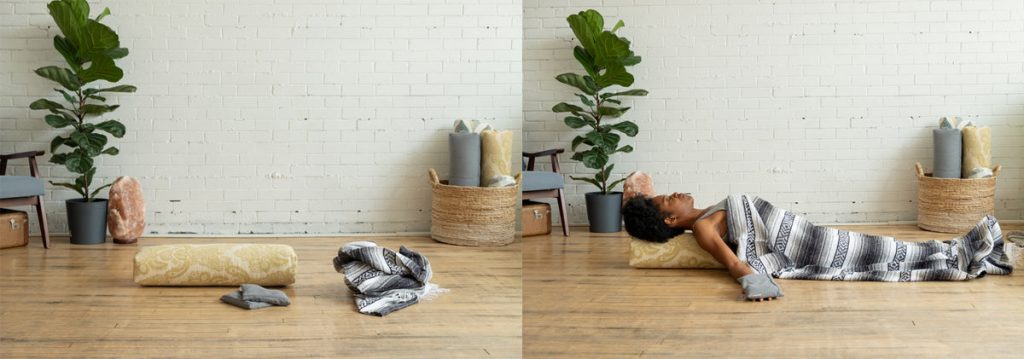Supported Fish Pose vs Reclined 30 Degree Angle Pose
Supported Fish Pose (Matsyasana with support) and the 30 Degree Angle/Reclined Pose are two yoga poses that emphasize opening the chest and improving posture, but they differ in their approach and benefits.
Supported Fish Pose
In Supported Fish Pose, you lie on your back with a bolster or block placed under your upper back and head, allowing the chest to gently open. This passive stretch helps release tension in the shoulders, improve posture, and encourage deep breathing. It’s especially useful for those who spend a lot of time hunched over, as it counteracts the rounding of the shoulders. However, those with neck or lower back issues should be cautious with this pose, as the backbend may cause discomfort if not properly supported.
30 Degree Angle/Reclined Pose
In contrast, the 30 Degree Angle/Reclined Pose is a gentler, more active posture. In this pose, you recline at a slight 30-degree angle, often with the help of props like bolsters, keeping your back supported while the chest opens naturally. This position provides a milder stretch compared to Supported Fish and can be especially beneficial for beginners or those with sensitive necks and backs. The angle helps engage core muscles and gently lengthens the spine without placing too much strain on any specific area. However, if you have severe back issues, this pose should be modified with proper support to ensure comfort and alignment.
Why Chest Openers Matter in Today’s World
In our modern lives, we spend countless hours sitting at desks, working on computers, scrolling on phones, or driving. These habits often pull us into spinal flexion—a rounded posture that collapses the chest, shortens the front body, and overworks the upper back. Over time, this posture can lead to shallow breathing, tight shoulders, back pain, and even low energy.
Practicing restorative yoga chest openers like Supported Fish Pose and the 30 Degree Angle Pose helps us restore balance by counteracting that forward slump. They create space across the chest and collarbones, gently re-educating the body to open and breathe deeply again.
Here are a few reasons why chest-opening poses are so important:
Counteract forward posture – Release the habitual rounding of shoulders from sitting and screen use.
Support lung capacity – Expanding the chest makes room for deeper, more efficient breathing.
Boost energy levels – More oxygen intake helps you feel more awake, grounded, and focused.
Relieve tension – Chest openers reduce tightness in the shoulders, upper back, and neck.
Improve posture awareness – Encourages an open, upright stance that feels better both physically and mentally.
Emotional release – Opening the heart space can help ease stress, anxiety, or feelings of heaviness.
Making chest openers part of your regular practice is an easy way to balance the effects of daily life, whether you’re looking for deeper relaxation, improved posture, or simply a chance to breathe more fully.
Leave a Reply Cancel reply
Recent Comments
Archives
- December 2025
- November 2025
- October 2025
- September 2025
- August 2025
- July 2025
- June 2025
- May 2025
- April 2025
- March 2025
- February 2025
- January 2025
- December 2024
- November 2024
- October 2024
- September 2024
- August 2024
- July 2024
- June 2024
- May 2024
- April 2024
- March 2024
- February 2024
- January 2024
- December 2023
- November 2023
- October 2023
- September 2023
- August 2023
- July 2023
- May 2023
- March 2023
- August 2022
- July 2022
- June 2022
- May 2022
- April 2022
- March 2022
- February 2022
- January 2022
- December 2021
- November 2021
- October 2021
- September 2021
- August 2021
- July 2021
- June 2021
- May 2021
- April 2021
- March 2021
- February 2020
- January 2020
Theme by The WP Club . Proudly powered by WordPress
